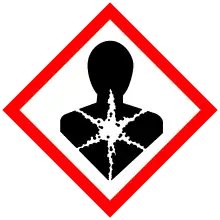N-Isopropyl-N'-phenyl-1,4-phenylenediamine
N-Isopropyl-N′-phenyl-1,4-phenylenediamine (often abbreviated IPPD) is an organic compound commonly used as an antiozonant in rubbers,[1] particularly those used for tires. Like other p-phenylenediamine-based antiozonants it works by virtue of its low ionization energy, which allows it to react with ozone faster than ozone will react with rubber.[2] This reaction converts it to the corresponding aminoxyl radical (R2N–O•), with the ozone being converted to a hydroperoxyl radical (HOO•),[2] these species can then be scavenged by other antioxidant polymer stabilizers.
 | |
| Names | |
|---|---|
| IUPAC name
1-N-phenyl-4-N-propan-2-ylbenzene-1,4-diamine | |
Other names
| |
| Identifiers | |
3D model (JSmol) |
|
| ChEMBL | |
| ChemSpider | |
| ECHA InfoCard | 100.002.700 |
| EC Number |
|
PubChem CID |
|
| RTECS number |
|
| UNII | |
| UN number | 1673 |
CompTox Dashboard (EPA) |
|
| |
| |
| Properties | |
| C15H18N2 | |
| Molar mass | 226.323 g·mol−1 |
| Appearance | dark grey flakes |
| Density | 1.04 |
| Melting point | 75 °C (167 °F; 348 K) |
| Hazards | |
| GHS pictograms |    |
| GHS Signal word | Danger |
| H302, H317, H320, H371, H372, H373, H400, H410 | |
| P260, P261, P264, P270, P272, P273, P280, P301+312, P302+352, P305+351+338, P309+311, P314, P321, P330, P333+313, P337+313, P363, P391, P405, P501 | |
Except where otherwise noted, data are given for materials in their standard state (at 25 °C [77 °F], 100 kPa). | |
| Infobox references | |
IPPD is prone to process called blooming, where it migrates to the surface of the rubber.[3]
See also
- N,N'-Di-2-butyl-1,4-phenylenediamine - a phenylenediamine based antioxidant used as a fuel additive
- 6PPD another phenylenediamine antiozonant
References
- Lewis, P.M. (January 1986). "Effect of ozone on rubbers: Countermeasures and unsolved problems". Polymer Degradation and Stability. 15 (1): 33–66. doi:10.1016/0141-3910(86)90004-2.
- Cataldo, Franco (January 2018). "Early stages of p-phenylenediamine antiozonants reaction with ozone: Radical cation and nitroxyl radical formation". Polymer Degradation and Stability. 147: 132–141. doi:10.1016/j.polymdegradstab.2017.11.020.
- Choi, Sung-Seen (5 July 1997). "Migration of Antidegradants to the Surface in NR and SBR Vulcanizates". Journal of Applied Polymer Science. 65 (1): 117–125. doi:10.1002/(SICI)1097-4628(19970705)65:1<117::AID-APP15>3.0.CO;2-0.
- Lammintausta, K; Kalimo, K (1985). "Sensitivity to Rubber. Study with Rubber Mixes and Individual Rubber Chemicals". Dermatosen in Beruf und Umwelt. Occupation and Environment. 33 (6): 204–8. PMID 2936592.
- Conde-Salazar, Luis; del-Río, Emilio; Guimaraens, Dolores; Domingo, Antonia González (August 1993). "Type IV Allergy to Rubber Additives: A 10-Year Study of 686 Cases". Journal of the American Academy of Dermatology. 29 (2): 176–180. doi:10.1016/0190-9622(93)70163-N.
This article is issued from Wikipedia. The text is licensed under Creative Commons - Attribution - Sharealike. Additional terms may apply for the media files.
